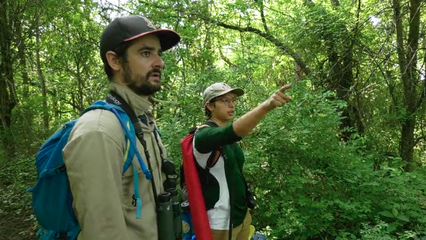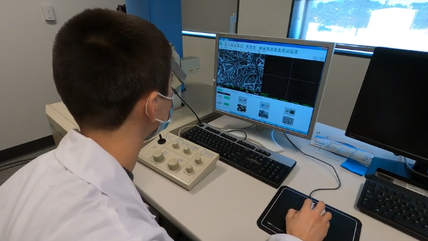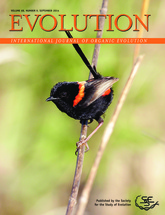2023
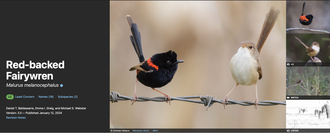
RED-BACKED FAIRYWREN BIRDS OF THE WORLD SPECIES ACCOUNT PUBLISHED!
With Emma Greig and Mike Webster, we finally put together the definitive species account for everyone's favorite promiscuous puffball! This was a true pandemic project and I'm so happy to have it see the light of day. Check it out and amaze your friends with esoteric – yet scientifically accurate – fairywren knowledge!
With Emma Greig and Mike Webster, we finally put together the definitive species account for everyone's favorite promiscuous puffball! This was a true pandemic project and I'm so happy to have it see the light of day. Check it out and amaze your friends with esoteric – yet scientifically accurate – fairywren knowledge!
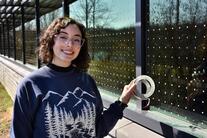
BROOKE'S WINDOW STRIKE PROJECT FEATURED
For several years, lab member Brooke Goodman has been coordinating efforts on the SUNY Oswego campus to research, document, and prevent bird window strikes. Her had work has resulted in several windows being retrofitted with bird deterrents. Thank you Brooke for volunteering your time to help make the campus safer for birds!
For several years, lab member Brooke Goodman has been coordinating efforts on the SUNY Oswego campus to research, document, and prevent bird window strikes. Her had work has resulted in several windows being retrofitted with bird deterrents. Thank you Brooke for volunteering your time to help make the campus safer for birds!
2022
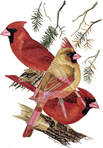
NEW PAPER IN WILSON JOURNAL OF ORNITHOLOGY
Led by SUNY Oswego undergrads Haley Bedell, Kristie Drzewiecki, Brooke Goodman, Mya Mills, and Denis Ramos; our cardinal urban ecology paper was selected as the frontispiece in the Wilson Journal of Ornithology! We analyzed visual signals of urban vs rural males and females and found urban birds had enhanced signals. This could be due to the prevalence of exotic plants like honeysuckles in urban areas. Some honeysuckles contain red carotenoids that cardinals could easily deposit in their feathers and bills to produce boosted signals, even while suffering potential health costs of living in cities. Check the Twitter thread for more info.
Led by SUNY Oswego undergrads Haley Bedell, Kristie Drzewiecki, Brooke Goodman, Mya Mills, and Denis Ramos; our cardinal urban ecology paper was selected as the frontispiece in the Wilson Journal of Ornithology! We analyzed visual signals of urban vs rural males and females and found urban birds had enhanced signals. This could be due to the prevalence of exotic plants like honeysuckles in urban areas. Some honeysuckles contain red carotenoids that cardinals could easily deposit in their feathers and bills to produce boosted signals, even while suffering potential health costs of living in cities. Check the Twitter thread for more info.
TALK AT SOUTHERN ADIRONDACK AUDUBON SOCIETY
I was delighted to give a talk to the Southern Adirondack Audubon Society on my students' research on the various ways urbanization affects Northern Cardinals. Check out the recorded talk here (skip to 4:20):
I was delighted to give a talk to the Southern Adirondack Audubon Society on my students' research on the various ways urbanization affects Northern Cardinals. Check out the recorded talk here (skip to 4:20):
TALK AT VIRTUAL WILSON ORNITHOLOGICAL SOCIETY MEETING
I gave a talk on Northern Cardinal urban ecology for the 2022 virtual Wilson Ornithological Society meeting. Check out the recorded talk here:
I gave a talk on Northern Cardinal urban ecology for the 2022 virtual Wilson Ornithological Society meeting. Check out the recorded talk here:
2021
DAN AND BROOKE PRESENT TO THE ASSOCIATION OF FIELD ORNITHOLOGISTS
The Association of Field Ornithologists hosts a wonderful series of informal talks on bird research called AFO Café. Dan and Brooke teamed up to present their research on how urbanization affects visual and acoustic signaling in cardinals. Check out the YouTube recording below (the talk starts at 7:36)!
The Association of Field Ornithologists hosts a wonderful series of informal talks on bird research called AFO Café. Dan and Brooke teamed up to present their research on how urbanization affects visual and acoustic signaling in cardinals. Check out the YouTube recording below (the talk starts at 7:36)!
VIDEOS HIGHLIGHTING STUDENT RESEARCH
The SUNY Oswego Office of Communications and Marketing put together two great videos highlighting some of the fun and impactful research led by my undergraduate students.
The SUNY Oswego Office of Communications and Marketing put together two great videos highlighting some of the fun and impactful research led by my undergraduate students.
TALK AT VIRTUAL AMERICAN ORNITHOLOGICAL SOCIETY MEETING
I gave a talk on Northern Cardinal urban ecology for the 2021 virtual American Ornithological Society meeting. Check out the recorded talk here:
I gave a talk on Northern Cardinal urban ecology for the 2021 virtual American Ornithological Society meeting. Check out the recorded talk here:
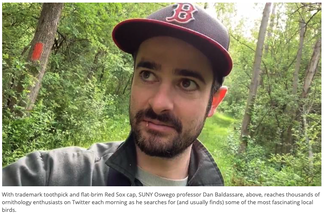
TWO INTERVIEWS IN THE OSWEGO PALLADIUM-TIMES NEWSPAPER
I gave two recent interviews to the Oswego Palladium-Times: one regarding the recent uptick in Bald Eagle sightings in Central New York, and one about my commitment to social media outreach. I'm grateful to have support from the local press!
I gave two recent interviews to the Oswego Palladium-Times: one regarding the recent uptick in Bald Eagle sightings in Central New York, and one about my commitment to social media outreach. I'm grateful to have support from the local press!
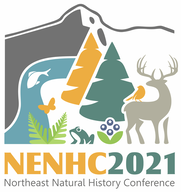
DAN AND BROOKE PRESENT AT NENHC 2021
Dan presented a talk on our preliminary analyses showing differences in urban and rural cardinal color. Brooke presented a stellar poster describing her methods for analyzing ARU recordings to quantify cardinal repertoire. Check out Dan's talk below. Both projects are ongoing, so stay tuned for more results!
Dan presented a talk on our preliminary analyses showing differences in urban and rural cardinal color. Brooke presented a stellar poster describing her methods for analyzing ARU recordings to quantify cardinal repertoire. Check out Dan's talk below. Both projects are ongoing, so stay tuned for more results!

BROOKE GOODMAN'S RESEARCH FEATURED
My phenomenal student Brooke Goodman has her cardinal song research featured on the Rice Creek Field Station website. She also gave a great interview about her project and how she got interested in birds. Brooke is a superstar!
My phenomenal student Brooke Goodman has her cardinal song research featured on the Rice Creek Field Station website. She also gave a great interview about her project and how she got interested in birds. Brooke is a superstar!
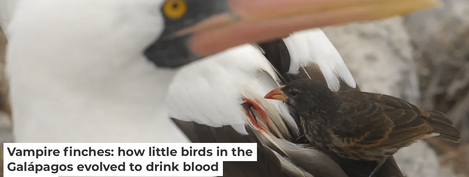
POPULAR SCIENCE ARTICLE ON VAMPIRE FINCHES
With my friends Kiyoko Gotanda and Jaime Chaves, I coauthored a short piece in The Conversation on our research with vampire finches. Check it out to learn about their evolutionary history, adaptations for blood feeding, and what it's like to work with them in the field.
With my friends Kiyoko Gotanda and Jaime Chaves, I coauthored a short piece in The Conversation on our research with vampire finches. Check it out to learn about their evolutionary history, adaptations for blood feeding, and what it's like to work with them in the field.
2020
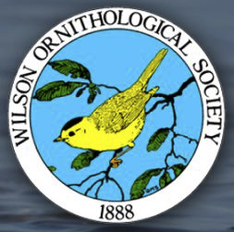
ELECTED AS COUNCILOR FOR WILSON ORNITHOLOGICAL SOCIETY
I was honored to be chosen as an Elected Councilor for the Wilson Ornithological Society. I have always loved WOS and appreciated their focus on supporting and encouraging students early in their ornithological careers. I am excited to help guide the society going forward!
I was honored to be chosen as an Elected Councilor for the Wilson Ornithological Society. I have always loved WOS and appreciated their focus on supporting and encouraging students early in their ornithological careers. I am excited to help guide the society going forward!
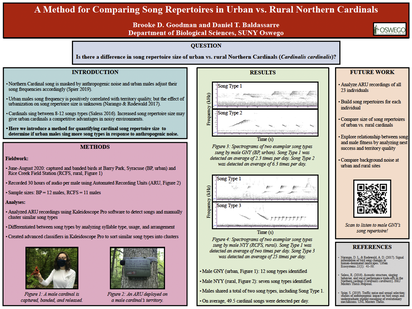
UNDERGRADUATE STUDENT POSTER
Brooke Goodman presented her poster outlining a method to use Automated Recording Units (ARUs) to compare urban and rural cardinal song repertoires at the 2020 Summer Scholarly and Creative Activities Virtual Symposium. This work is ongoing, and Brooke plans to continue working on this project for her honor's thesis. Nice work Brooke!
Brooke Goodman presented her poster outlining a method to use Automated Recording Units (ARUs) to compare urban and rural cardinal song repertoires at the 2020 Summer Scholarly and Creative Activities Virtual Symposium. This work is ongoing, and Brooke plans to continue working on this project for her honor's thesis. Nice work Brooke!
TALK AT VIRTUAL ANIMAL BEHAVIOR SOCIETY MEETING
I gave a talk on Phainopepla itinerant breeding for the 2020 virtual Animal Behavior Society meeting. Check out the recorded talk here:
I gave a talk on Phainopepla itinerant breeding for the 2020 virtual Animal Behavior Society meeting. Check out the recorded talk here:
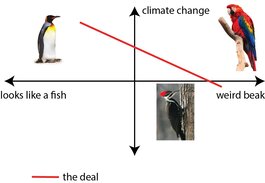
EXPOSING PREDATORY JOURNALS
Predatory journals are money-making scams that offer to publish papers for a fee, but don't subject the papers to any sort of peer review. If you're a scientist, you'll be familiar with these scams- you probably have ten emails from them in your spam folder right now. In order to bring attention to this issue and make the point that we should not trust anything published in these journals, I submitted a manuscript entitled "What's the deal with birds?" with the following abstract:
Many people wonder: what’s the deal with birds? This is a common query. Birds are pretty weird. I mean, they have feathers. WTF? Most other animals don’t have feathers. To investigate this issue, I looked at some birds. I looked at a woodpecker, a parrot, and a penguin. They were all pretty weird! In conclusion, we may never know the deal with birds, but further study is warranted.
I documented the entire saga on Twitter, which ultimately culminated in the paper being published (eventually the "journal" got wise and removed the paper from their website, see PDF below), going viral on social media, and being covered by a few media outlets (below). I'm glad so many people found the paper humorous, but also got a window into the sketchy world of predatory journals. I hope by brining attention to this issue, fewer people will be tricked into publishing in them, and we will all be appropriately skeptical of what we read online!
News coverage: The Week, Gizmodo, Audubon Magazine, KIJK Magazine, Ducks Unlimited Podcast
Predatory journals are money-making scams that offer to publish papers for a fee, but don't subject the papers to any sort of peer review. If you're a scientist, you'll be familiar with these scams- you probably have ten emails from them in your spam folder right now. In order to bring attention to this issue and make the point that we should not trust anything published in these journals, I submitted a manuscript entitled "What's the deal with birds?" with the following abstract:
Many people wonder: what’s the deal with birds? This is a common query. Birds are pretty weird. I mean, they have feathers. WTF? Most other animals don’t have feathers. To investigate this issue, I looked at some birds. I looked at a woodpecker, a parrot, and a penguin. They were all pretty weird! In conclusion, we may never know the deal with birds, but further study is warranted.
I documented the entire saga on Twitter, which ultimately culminated in the paper being published (eventually the "journal" got wise and removed the paper from their website, see PDF below), going viral on social media, and being covered by a few media outlets (below). I'm glad so many people found the paper humorous, but also got a window into the sketchy world of predatory journals. I hope by brining attention to this issue, fewer people will be tricked into publishing in them, and we will all be appropriately skeptical of what we read online!
News coverage: The Week, Gizmodo, Audubon Magazine, KIJK Magazine, Ducks Unlimited Podcast
| What's the deal with birds?.pdf | |
| File Size: | 467 kb |
| File Type: | |
2019
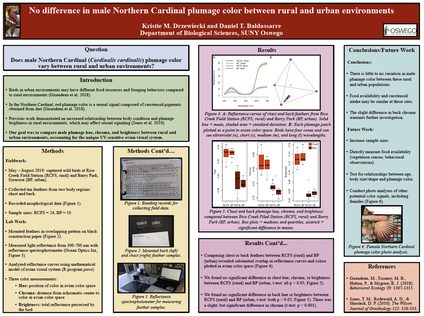
UNDERGRADUATE STUDENT POSTER
Kristie Drzewiecki presented her poster comparing urban and rural cardinal plumage color at the 2019 Rochester Academy of Science meeting. This work is ongoing, and Kristie plans to continue working on this project for her honor's thesis. Nice work Brooke!
Kristie Drzewiecki presented her poster comparing urban and rural cardinal plumage color at the 2019 Rochester Academy of Science meeting. This work is ongoing, and Kristie plans to continue working on this project for her honor's thesis. Nice work Brooke!
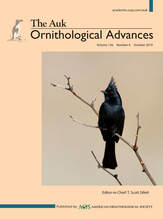
NEW PAPER ON THE COVER OF THE AUK
During my postdoc with Christie Riehl at Princeton University I studied itinerant breeding in the Phainopepla. This paper summarizes our results: 1) Phainopeplas tracked with GPS tags move between desert and woodland breeding habitats in the same year, 2) population genomics show no genetic structure among desert and woodland populations, and 3) random forest analyses identify unique environmental conditions experienced by birds in these two breeding habitats as well as stopover sites. Many thanks to my great coauthors!
News coverage: Audubon Magazine, Scientific American, Cosmos Magazine
During my postdoc with Christie Riehl at Princeton University I studied itinerant breeding in the Phainopepla. This paper summarizes our results: 1) Phainopeplas tracked with GPS tags move between desert and woodland breeding habitats in the same year, 2) population genomics show no genetic structure among desert and woodland populations, and 3) random forest analyses identify unique environmental conditions experienced by birds in these two breeding habitats as well as stopover sites. Many thanks to my great coauthors!
News coverage: Audubon Magazine, Scientific American, Cosmos Magazine
2018
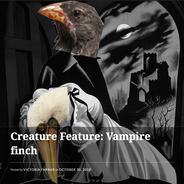
VAMPIRE FINCH BLOG POST FROM UC DAVIS ANIMAL BEHAVIOR GROUP
Victoria Farrar, a PhD student at UC Davis wrote a great blog post about vampire finches for The Ethogram. Check it out for a great overview of what we know about the the evolution of blood-feeding in finches.
Victoria Farrar, a PhD student at UC Davis wrote a great blog post about vampire finches for The Ethogram. Check it out for a great overview of what we know about the the evolution of blood-feeding in finches.
'SCIENCE TODAY' TALK AT SUNY OSWEGO
Check out a recent talk I gave as part of the Science Today seminar series at SUNY Oswego. This talk is a broad overview of my research, including recent projects and what I have planned as Oswego.
Check out a recent talk I gave as part of the Science Today seminar series at SUNY Oswego. This talk is a broad overview of my research, including recent projects and what I have planned as Oswego.
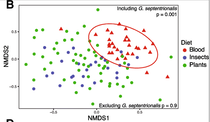
COLLABORATIVE PAPER ON VAMPIRE FINCH MICROBIOME
Alice Michel and Lewis Ward at Cal Tech led the way on a very cool paper analyzing the gut microbiome of 12 species of Darwin's finches, including the vampire finch. The vampire finch gut is home to several bacteria that are absent or very rare in other finch species, but found in other carnivorous species. These results support the idea that a suite of physiological adaptations have allowed the vampire finch to capitalize on this bizarre food resource.
Alice Michel and Lewis Ward at Cal Tech led the way on a very cool paper analyzing the gut microbiome of 12 species of Darwin's finches, including the vampire finch. The vampire finch gut is home to several bacteria that are absent or very rare in other finch species, but found in other carnivorous species. These results support the idea that a suite of physiological adaptations have allowed the vampire finch to capitalize on this bizarre food resource.

PAPER ON THE COVER OF JOURNAL OF AVIAN BIOLOGY
I collaborated with Mark Hauber, Miri Dainson, Marouf Hossain, Mande Holford, and Christie Riehl on a paper examining the chemical and spectral properties of greater ani eggs with and without their bizarre white chalky vaterite coating.
I collaborated with Mark Hauber, Miri Dainson, Marouf Hossain, Mande Holford, and Christie Riehl on a paper examining the chemical and spectral properties of greater ani eggs with and without their bizarre white chalky vaterite coating.
2017

FACULTY POSITION BEGINNING FALL 2018
I will be joining the SUNY Oswego Department of Biological Sciences in Fall 2018 as Assistant Professor of Zoology. I look forward to teaching Ornithology, Evolution, and Behavioral Ecology, as well as conducting local research that engages undergraduates.
I will be joining the SUNY Oswego Department of Biological Sciences in Fall 2018 as Assistant Professor of Zoology. I look forward to teaching Ornithology, Evolution, and Behavioral Ecology, as well as conducting local research that engages undergraduates.
2016

(ANOTHER) IRISH RADIO INTERVIEW
Turns out Irish radio producers love fairy-wrens! Who can blame them really? I recently did a second interview on Irish radio, this time for RTE's Mooney Goes Wild program. Click the radio logo to listen to the archived recording, and skip to the 13 minute mark.
Turns out Irish radio producers love fairy-wrens! Who can blame them really? I recently did a second interview on Irish radio, this time for RTE's Mooney Goes Wild program. Click the radio logo to listen to the archived recording, and skip to the 13 minute mark.
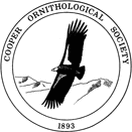
COOPER ORNITHOLOGICAL SOCIETY YOUNG PROFESSIONAL AWARD
I'm very honored to receive the 2016 Young Professional Award from the Cooper Ornithological Society. Some of my favorite early career ornithologists have won this recently. Thank you to the COS YPA committee for this honor. I will officially receive the award and present a summary of my research at the NAOC meeting in Washington, DC this August.
I'm very honored to receive the 2016 Young Professional Award from the Cooper Ornithological Society. Some of my favorite early career ornithologists have won this recently. Thank you to the COS YPA committee for this honor. I will officially receive the award and present a summary of my research at the NAOC meeting in Washington, DC this August.

NEW POSTDOC POSITION ACCEPTED
On July 1 I will be starting a new postdoc with Christie Riehl at Princeton University. I am really excited about this opportunity. The plan is to work on phenotypic plasticity in the phainopepla, a really bizarre bird that breeds in two completely different physical and social environments in the southwestern USA.
On July 1 I will be starting a new postdoc with Christie Riehl at Princeton University. I am really excited about this opportunity. The plan is to work on phenotypic plasticity in the phainopepla, a really bizarre bird that breeds in two completely different physical and social environments in the southwestern USA.

NEW PAPER OUT IN BIOLOGY LETTERS
Red-backed fairy-wrens are known for their extremely promiscuous mating system. This means males often raise offspring that are not their own. We hypothesized that two prominent behaviors that vary among males - physical aggression and duetting - could be used to help a male maintain paternity. Aggression might keep rivals away from the female, and duetting might be used to signal commitment or mate guard. We found that aggression did not impact male paternity, but males with strong duet responses were best able to maintain paternity in their nests. This is the first study to directly demonstrate that duetting can lead to increased paternity assurance. This is good evidence that birds may use vocal communication to mediate extra-pair mating decisions. Big thanks to coauthors Emma Greig and Mike Webster!
Some popular press on this research:
Science, The Economist, The Australian, Wall Street Journal, Forbes, Bionieuws, Cage & Aviary Birds
Irish national radio interview:
Moncrieff Show, March 15 2016 (Third segment, interview starts about a third of the way through.)
Red-backed fairy-wrens are known for their extremely promiscuous mating system. This means males often raise offspring that are not their own. We hypothesized that two prominent behaviors that vary among males - physical aggression and duetting - could be used to help a male maintain paternity. Aggression might keep rivals away from the female, and duetting might be used to signal commitment or mate guard. We found that aggression did not impact male paternity, but males with strong duet responses were best able to maintain paternity in their nests. This is the first study to directly demonstrate that duetting can lead to increased paternity assurance. This is good evidence that birds may use vocal communication to mediate extra-pair mating decisions. Big thanks to coauthors Emma Greig and Mike Webster!
Some popular press on this research:
Science, The Economist, The Australian, Wall Street Journal, Forbes, Bionieuws, Cage & Aviary Birds
Irish national radio interview:
Moncrieff Show, March 15 2016 (Third segment, interview starts about a third of the way through.)
2015
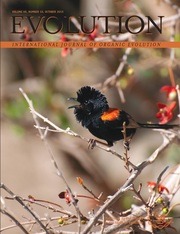
PAPER ON THE COVER OF EVOLUTION
My final dissertation chapter analyzing how male response to multimodal signals relates to differential introgression across the red-backed fairy-wren hybrid zone just made the cover of Evolution! Emma Greig and Mike Webster are my intrepid coauthors on this one. Big thanks especially to Emma who took the lead on this. We found that males did not distinguish between red and orange mount colors, but responded most strongly to the local song type. These results suggest that song can serve as a barrier to gene flow between subspecies, but that the observed introgression of red plumage into the orange subspecies must be driven by something other than male-male interactions (likely female preference for red). This study also highlights the importance of measuring behavioral responses to multiple signals simultaneously.
My final dissertation chapter analyzing how male response to multimodal signals relates to differential introgression across the red-backed fairy-wren hybrid zone just made the cover of Evolution! Emma Greig and Mike Webster are my intrepid coauthors on this one. Big thanks especially to Emma who took the lead on this. We found that males did not distinguish between red and orange mount colors, but responded most strongly to the local song type. These results suggest that song can serve as a barrier to gene flow between subspecies, but that the observed introgression of red plumage into the orange subspecies must be driven by something other than male-male interactions (likely female preference for red). This study also highlights the importance of measuring behavioral responses to multiple signals simultaneously.
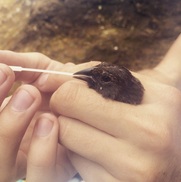
SUCCESSFUL GALÁPAGOS FIELD SEASON
I spent six weeks in the Galápagos collecting data for my postdoctoral research project on blood feeding in the vampire finch. The Galápagos are a crazy place to work- the landscape is harsh and rugged and logistical difficulties abound. Nonetheless, I managed to catch plenty of finches on some spectacular remote islands. Check out the photos section for some images from the trip. Now to analyze the data!
I spent six weeks in the Galápagos collecting data for my postdoctoral research project on blood feeding in the vampire finch. The Galápagos are a crazy place to work- the landscape is harsh and rugged and logistical difficulties abound. Nonetheless, I managed to catch plenty of finches on some spectacular remote islands. Check out the photos section for some images from the trip. Now to analyze the data!

INTERACTIVE WEB FEATURE ON FAIRY-WREN EXPERIMENT
The amazing people over at All About Bird Biology at the Cornell Lab of Ornithology put together a great series of interactive web features called "All About Fancy Males". One of the features is about the plumage manipulation experiment I did on red-backed fairy-wrens. Click the illustration to check it out!
The amazing people over at All About Bird Biology at the Cornell Lab of Ornithology put together a great series of interactive web features called "All About Fancy Males". One of the features is about the plumage manipulation experiment I did on red-backed fairy-wrens. Click the illustration to check it out!
2014
|
PAPER ON THE COVER OF EVOLUTION
My paper on the genomic and plumage color characteristics of the red-backed fairy-wren hybrid zone made the cover of the September issue of Evolution! The wonderful photo is by my good friend from Australia, Tom Tarrant. Thanks to my coauthors who made this such a great paper: Tom White, Jordan Karubian, and Mike Webster. |

POSTDOCTORAL FELLOWSHIP RECEIVED
I was awarded an NSF Postdoctoral Research Fellowship in Biology to study the molecular, ecological, and behavioral function of blood-feeding in the vampire finch. The vampire finch is one of the Darwin's finches endemic to the Galápagos Islands. Certain subspecies attack seabirds and drink their blood. My research will investigate why they do this and whether they have evolved physiological adaptations similar to other blood-feeding animals like vampire bats, mosquitos, and ticks. I will be joining Dr. Al Uy's lab at the University of Miami to conduct this research.
I was awarded an NSF Postdoctoral Research Fellowship in Biology to study the molecular, ecological, and behavioral function of blood-feeding in the vampire finch. The vampire finch is one of the Darwin's finches endemic to the Galápagos Islands. Certain subspecies attack seabirds and drink their blood. My research will investigate why they do this and whether they have evolved physiological adaptations similar to other blood-feeding animals like vampire bats, mosquitos, and ticks. I will be joining Dr. Al Uy's lab at the University of Miami to conduct this research.

TEACHING AWARD RECEIVED
After being nominated by the NBB department chair, Dr. Thomas Seeley, I won the Cornell College of Arts and Sciences Dean's Prize for Distinguished Teaching. This award was given to recognize the success of my writing seminar Flock and Awe: Extreme Ornithology. Thanks to Tom for nominating me, and to all my great students for making the class so fun to teach!
After being nominated by the NBB department chair, Dr. Thomas Seeley, I won the Cornell College of Arts and Sciences Dean's Prize for Distinguished Teaching. This award was given to recognize the success of my writing seminar Flock and Awe: Extreme Ornithology. Thanks to Tom for nominating me, and to all my great students for making the class so fun to teach!
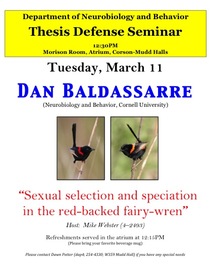
SUCCESSFUL DISSERTATION DEFENSE!
I successfully defended my dissertation and gave a public seminar entitled "Sexual selection and speciation in the red-backed fairy-wren" on Tuesday, March 11. I will submit my dissertation to the Graduate School in May.
I successfully defended my dissertation and gave a public seminar entitled "Sexual selection and speciation in the red-backed fairy-wren" on Tuesday, March 11. I will submit my dissertation to the Graduate School in May.
2013

PAPER PUBLISHED AND POPULAR PRESS
My paper on how extra-pair mating drives asymmetrical introgression of plumage color in the red-backed fairy-wren was published in Proceedings of the Royal Society B: Biological Sciences. The Cornell Lab of Ornithology put out a nice press release, and a few news outlets did stories about the research. Here few highlights:
NBC News, ABC News Australia, AAAS Science Update
My paper on how extra-pair mating drives asymmetrical introgression of plumage color in the red-backed fairy-wren was published in Proceedings of the Royal Society B: Biological Sciences. The Cornell Lab of Ornithology put out a nice press release, and a few news outlets did stories about the research. Here few highlights:
NBC News, ABC News Australia, AAAS Science Update
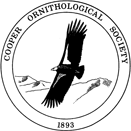
PRESENTATION AWARD
I won the Cooper Ornithological Society Board of Directors Award for best student paper presented at the 2013 joint American Ornithologists' Union/Cooper Ornithological Society meeting in Chicago, IL. My talk was titled "Experimental evidence that extra-pair mating drives asymmetrical introgression of a sexual trait."
I won the Cooper Ornithological Society Board of Directors Award for best student paper presented at the 2013 joint American Ornithologists' Union/Cooper Ornithological Society meeting in Chicago, IL. My talk was titled "Experimental evidence that extra-pair mating drives asymmetrical introgression of a sexual trait."
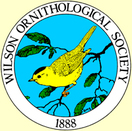
PRESENTATION AWARD
I won the Alexander Wilson Prize for best student paper presented at the 2013 Wilson Ornithological Society meeting at the College of William and Mary in Williamsburg, VA. My talk was titled "Experimental evidence of asymmetrical introgression of a sexual trait via extra-pair mating."
I won the Alexander Wilson Prize for best student paper presented at the 2013 Wilson Ornithological Society meeting at the College of William and Mary in Williamsburg, VA. My talk was titled "Experimental evidence of asymmetrical introgression of a sexual trait via extra-pair mating."

PAPER PUBLISHED
My paper on how the environment shapes geographic variation in sexual and non-sexual traits in the red-backed fairy-wren was published open access in BMC Evolutionary Biology.
My paper on how the environment shapes geographic variation in sexual and non-sexual traits in the red-backed fairy-wren was published open access in BMC Evolutionary Biology.
